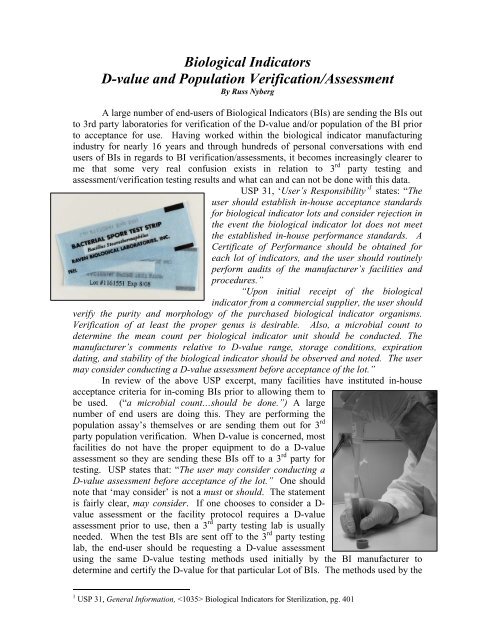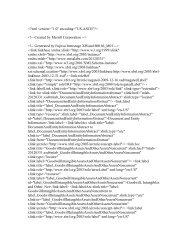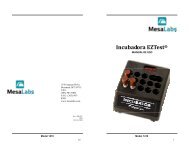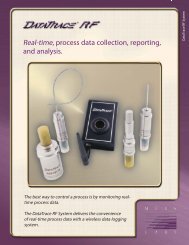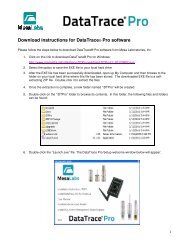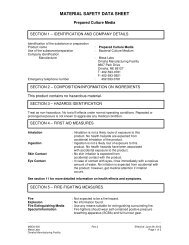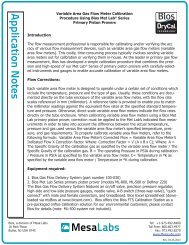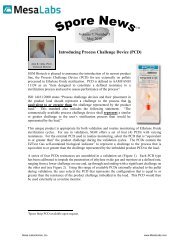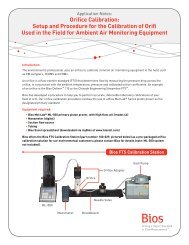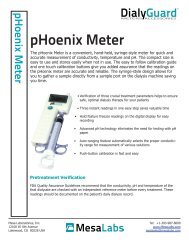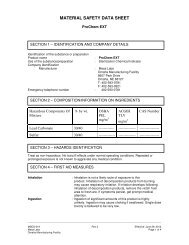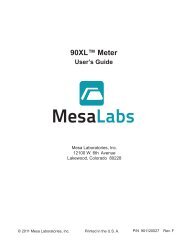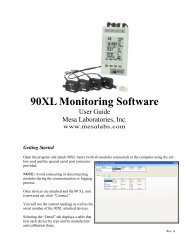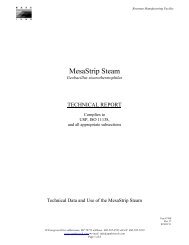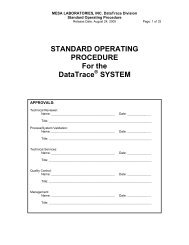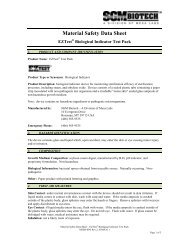Biological Indicators D-value and Population ... - Mesa Labs
Biological Indicators D-value and Population ... - Mesa Labs
Biological Indicators D-value and Population ... - Mesa Labs
Create successful ePaper yourself
Turn your PDF publications into a flip-book with our unique Google optimized e-Paper software.
<strong>Biological</strong> <strong>Indicators</strong><br />
D-<strong>value</strong> <strong>and</strong> <strong>Population</strong> Verification/Assessment<br />
By Russ Nyberg<br />
A large number of end-users of <strong>Biological</strong> <strong>Indicators</strong> (BIs) are sending the BIs out<br />
to 3rd party laboratories for verification of the D-<strong>value</strong> <strong>and</strong>/or population of the BI prior<br />
to acceptance for use. Having worked within the biological indicator manufacturing<br />
industry for nearly 16 years <strong>and</strong> through hundreds of personal conversations with end<br />
users of BIs in regards to BI verification/assessments, it becomes increasingly clearer to<br />
me that some very real confusion exists in relation to 3 rd party testing <strong>and</strong><br />
assessment/verification testing results <strong>and</strong> what can <strong>and</strong> can not be done with this data.<br />
USP 31, ‘User’s Responsibility’ 1 states: “The<br />
user should establish in-house acceptance st<strong>and</strong>ards<br />
for biological indicator lots <strong>and</strong> consider rejection in<br />
the event the biological indicator lot does not meet<br />
the established in-house performance st<strong>and</strong>ards. A<br />
Certificate of Performance should be obtained for<br />
each lot of indicators, <strong>and</strong> the user should routinely<br />
perform audits of the manufacturer’s facilities <strong>and</strong><br />
procedures.”<br />
“Upon initial receipt of the biological<br />
indicator from a commercial supplier, the user should<br />
verify the purity <strong>and</strong> morphology of the purchased biological indicator organisms.<br />
Verification of at least the proper genus is desirable. Also, a microbial count to<br />
determine the mean count per biological indicator unit should be conducted. The<br />
manufacturer’s comments relative to D-<strong>value</strong> range, storage conditions, expiration<br />
dating, <strong>and</strong> stability of the biological indicator should be observed <strong>and</strong> noted. The user<br />
may consider conducting a D-<strong>value</strong> assessment before acceptance of the lot.”<br />
In review of the above USP excerpt, many facilities have instituted in-house<br />
acceptance criteria for in-coming BIs prior to allowing them to<br />
be used. (“a microbial count…should be done.”) A large<br />
number of end users are doing this. They are performing the<br />
population assay’s themselves or are sending them out for 3 rd<br />
party population verification. When D-<strong>value</strong> is concerned, most<br />
facilities do not have the proper equipment to do a D-<strong>value</strong><br />
assessment so they are sending these BIs off to a 3 rd party for<br />
testing. USP states that: “The user may consider conducting a<br />
D-<strong>value</strong> assessment before acceptance of the lot.” One should<br />
note that ‘may consider’ is not a must or should. The statement<br />
is fairly clear, may consider. If one chooses to consider a D-<br />
<strong>value</strong> assessment or the facility protocol requires a D-<strong>value</strong><br />
assessment prior to use, then a 3 rd party testing lab is usually<br />
needed. When the test BIs are sent off to the 3 rd party testing<br />
lab, the end-user should be requesting a D-<strong>value</strong> assessment<br />
using the same D-<strong>value</strong> testing methods used initially by the BI manufacturer to<br />
determine <strong>and</strong> certify the D-<strong>value</strong> for that particular Lot of BIs. The methods used by the<br />
1 USP 31, General Information, <strong>Biological</strong> <strong>Indicators</strong> for Sterilization, pg. 401
BI manufacturer should be stated on the certificate of analysis (C of A) provided with the<br />
BI Lot. It is important to remember that in a D-<strong>value</strong> assessment test, you are getting<br />
from the 3 rd party lab just that, an assessment. An assessment is not the same as a<br />
determination.<br />
If the assessment is within the allowable + or – 20% of the certified D-<strong>value</strong><br />
stated on the manufacturers certificate of analysis, the assessment passes the test <strong>and</strong> the<br />
D-<strong>value</strong> ‘as certified’ on the C of A can be accepted <strong>and</strong> is to be used whenever that Lot<br />
of BIs is used. The certified D-<strong>value</strong> has been assessed, substantiated, supported or<br />
confirmed. Regardless of the terminology used, it is still an assessment. However, it is<br />
not to replace the manufacturers certified D-<strong>value</strong>. Unfortunately in far too many cases<br />
this is what is happening. The end user now uses the 3 rd party testing labs result for D-<br />
<strong>value</strong> (or population) as the “new, established D-<strong>value</strong>”. This just can not be done. The<br />
D-<strong>value</strong> testing assessment can not replace or be used to re-label the certified D-<strong>value</strong><br />
determined by the manufacturer. To initially determine <strong>and</strong> certify the manufacturers<br />
stated D-<strong>value</strong>, methods allowed by ISO <strong>and</strong> USP<br />
were used. As in ISO 11138 series, to obtain a<br />
label claim or certify a determined D-<strong>value</strong>, one<br />
must use two of the three methods outlined in ISO<br />
<strong>and</strong> USP 2 : Most Probable Number method by direct<br />
enumeration, a Fraction Negative Method (such as<br />
Spearman/Karber) or Survive/Kill. Whichever two<br />
methods are chosen, two of the three must be used<br />
for D-<strong>value</strong> determination. A 3 rd party assessment<br />
is not a determination <strong>and</strong> may not in any way be<br />
used to re-label a BIs resistance characteristic<br />
certified by the manufacturer.<br />
A similar situation exists with 3 rd party population verification. For the BI to pass<br />
the population verification, the population result needs to be within +300% <strong>and</strong> -50% of<br />
the labeled population. If the population being verified falls within this range, the<br />
requirements of the test are met <strong>and</strong> the population has been verified. However, the<br />
verified population is not the new certified population to be used in further studies<br />
or validations done with this Lot of BIs. In most situations, BI manufacturers are much<br />
more familiar with, have validated <strong>and</strong> have extended experience in performing<br />
population assays on their particular BIs. Having a 3 rd party labs assay result replace a<br />
manufacturers certified population, even if only slightly different than the C of A listed<br />
population makes little sense <strong>and</strong> is simply not to be done. The bottom line is that 3 rd<br />
Party verifications are only that, verifications, <strong>and</strong> are not in any way intended to replace<br />
a manufacturer’s certified BI characteristics such as D-<strong>value</strong> or population. Some testing<br />
labs are actually performing re-certifications <strong>and</strong> some end-users are using the 3 rd party<br />
verification to replace the C of A labeled <strong>value</strong>s. If verification criteria are met, the<br />
certified characteristics on the manufacturers C of A are to be used. I certainly would not<br />
want to be the one who re-labeled a medical device for use in my facility if I were the<br />
end-user of a purchased BI. The FDA may even consider this adulteration of a medical<br />
device.<br />
Author: Russ Nyberg is Director of Technical Support for the <strong>Biological</strong> Indicator manufacturing facility of<br />
Raven <strong>Labs</strong>, located in Omaha, Nebraska. Raven <strong>Labs</strong> is a division of <strong>Mesa</strong> Laboratories, Inc.<br />
2 USP, Microbiological Tests, Chapter , <strong>Biological</strong> <strong>Indicators</strong>-Resistance Performance Tests. ISO<br />
11138-1 Sterilization of Health Care Products, <strong>Biological</strong> <strong>Indicators</strong> Part 1.


